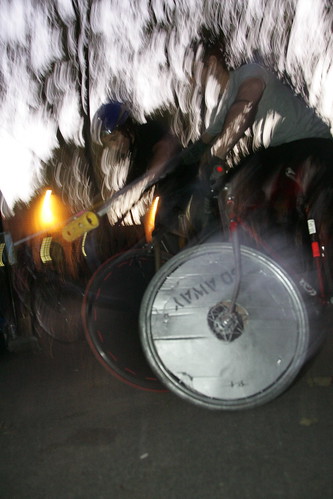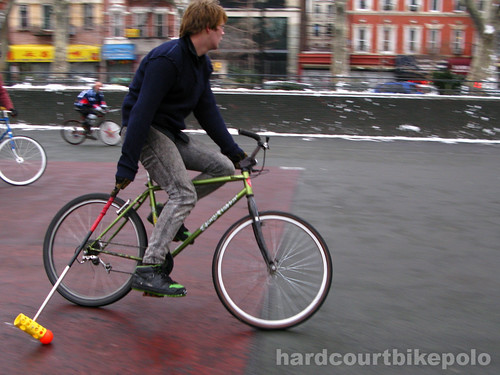Bike
Anything that you can steer with one hand while whacking a ball with the other.
OK, so that doesn't narrow it down much. Getting a bit more technical:
Low gear helps, as does a decent back brake. Narrow flat bars seem to be preferred over drops by most. Single speed reduces mechanical hassles - there's a chance your rear mech could get whacked or broken off entirely.
Strong wheels are pretty important as these take most of the pain from collisions, accidental mallet strikes and so on. If you like you can make wheel covers out of an old estate agent's sign - just cut to the same diameter as the inside part of your wheel, cut out a hole for the hub, cut a slot so it fits your wheel snugly, then zip-tie on. Full instructions (and some examples of wheel cover art) here.
There seems to be a misconception that you need a fixed wheel bike to play polo. Actually most off-the-peg fixed wheelers are pretty unsuitable, as they come with high gearing (meaning starting from a standstill is creaky and slow) and a brake that's on the wrong side. These things are pretty easy to fix though.
Equipment
The most important thing is a mallet - there's a guide to making one here.
Other stuff, like helmets, gloves and knee pads are optional. Polo can be a bit rough-and-tumble, but accidents tend to be low speed and it's rare for anyone to get seriously hurt. Just remember to plug your mallet and bar ends to avoid "core samples". Ugh.
Learning to play
The best way of learning is to come along to one of our evening sessions - Mondays and Thursdays, from about 6.30. There are a few techniques you can practice, such as the "ball joint" or reaching over your handlebars to pick up a ball on your non-mallet side, but in general you'll learn much more quickly if you play with other people.
The "ball joint" technique. Not as smutty as it sounds.


